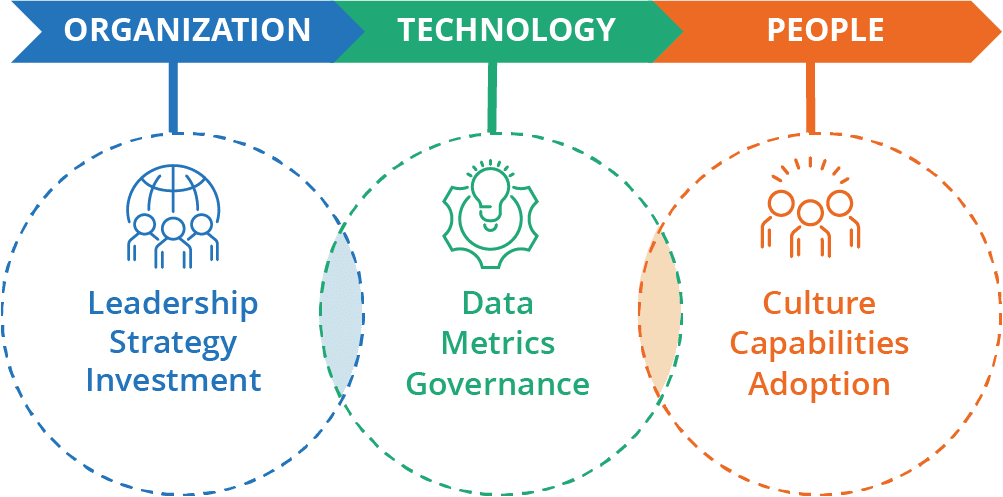The post People Analytics: How Rizing Helps Organizations Measure Their Analytical Capabilities appeared first on Rizing.
]]>People analytics.
Let’s define that phrase. It’s more than just people-watching at the local mall.
Research giant Gartner defines it as:
“The collection and application of talent data to improve critical talent and business outcomes. People analytics leaders enable HR leaders to develop data-driven insights to inform talent decisions, improve workforce processes and promote positive employee experience.”
While we can trace the origins of People Analytics back to the early 1900s, it came into its own in the 2000s with interest from companies like Google, Microsoft, and IBM.
Current State of People Analytics
Over the last decade, people analytics has grown from a “business extra” to a “can’t survive without” business need.
Today, 70% of companies invest in people analytics, but only 21% see the expected value.
And most companies are new to it. At Rizing, we’ve found that 70% of organizations started their people analytics program in the last 2-4 years.
But how do companies get a sense of where they are at with People Analytics?
Industry experts like Thomas Davenport have outlined how to conduct self-assessments. However, many analytical teams are too new to complete a self-assessment objectively.
Rizing’s People Analytics Maturity Model
At Rizing, we used existing research and industry expertise to develop our definitions of people analytics maturity. The definitions fall along a path. All organizations must start at the Foundational stage and get to the Leading stage as they develop their people analytics capabilities.
People Analytics Levels
1: Foundational | 2: Operational | 3: Insightful | 4: Strategic | 5: Leading |
| Organizations that haven't started or are about to start their analytics program | People analytics focused on providing point-in-time operational and compliance reports to ensure data accuracy, consistency, and timeliness. | People analytics are used to answer key business questions through identifying historical trends and determining where to take action. | People analytics are embedded in processes. Multiple data sources and types are combined to give insights into what is driving an outcome. HR program impacts can be evaluated. | Analytics are used to drive and predict outcomes, prescribe actions, evaluate the results of what-if scenarios, and make strategic decisions. |
| We can't easily report on how diverse our hiring is. | We know how diverse our hiring is. | We are learning what stages of hiring impact different diversity groups. | We understand the key drivers and where to invest in diverse hiring. | We can predict how different programs and actions will improve diverse hiring. |
There are two important considerations when interpreting analytics maturity levels:
Goals and Definitions
- Don’t try to be an analytics leader right away. Instead, work towards being Insightful or Strategic. Strive for a level three or four, then focus on maintaining it. You’ll still need to grow and improve to stay there.
- The definition of each level will evolve as new technologies and capabilities emerge. If an organization is stagnant, it’s possible to move down a maturity level because the definitions changed.
Get a baseline, then set a goal. Figure out your organization’s current level of maturity. Then determine what level to aim for to meet business needs and objectives.
Barriers and Challenges to Developing Analytical Capabilities
Rizing identified two common barriers and two common challenges that companies experience when developing analytical capabilities:
Barrier #1: Changes to the organization, leadership, or department
Losing a key sponsor, leader, or developer can stop a project. Especially if the project is young. These roles are critical for the success of new initiatives.
Connecting initiatives like developing analytical capabilities to the overall organizational strategy is crucial.
It’s equally important to retain key people. If they exit the project, either reassign the responsibilities or hire a replacement as soon as possible.
Barrier #2: Lack of investment in non-digital activities
Another common barrier is the lack of investment in non-digital activities:
- Immediate and ongoing training and support
- Documentation
- Ongoing updates
- Other change management activities
New analytical and digital initiatives often fall flat without the support of these non-digital activities.
Challenge #1: Not developing all areas together
Don’t just focus on the technology. Also, consider the social and organizational change involved when digital or analytical changes occur.
Challenge #2: Not realizing that maturity is a moving target
Don’t think analytical maturity is static with an endpoint. Instead, understand it’s a moving target. Experts in the industry are constantly advancing our understanding of analytical maturity.
Measuring Analytical Capabilities and Maturity
What do we measure regarding analytical capabilities and maturity? The intersection of organizations, technology, and people.
Rizing’s People Analytics Maturity Model (PAMM)
Advances in technology have significantly impacted how work gets done. New technology requires new processes, tasks, and expertise to deploy and maintain them.
This is part of the change that occurs when a new technology is brought into an organization.
Rizing’s people analytics maturity model starts with this change as the foundation. We then added change theory, systems thinking, and existing research to develop our model and assessment.
The result?
A reflective model able to predict the level of analytical maturity that an organization has achieved.
Key Drivers
Our model has three key drivers:
- Organizations
- Technology
- People
We evaluate these drivers with 23 variables that provide a deep understanding of your current analytical capabilities and highlight your strengths and weaknesses.
Rizing’s People Analytics Maturity Assessment (PAMA)
Rizing’s PAMA is a free, online 30-minute self-assessment. The results provide analytical and HR leaders with evidence outlining their capabilities and analytical maturity. The results also highlight their strengths and weaknesses and identify quick improvement wins.
Sample Results:
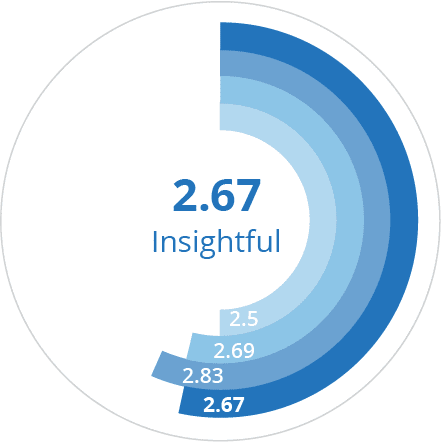 | 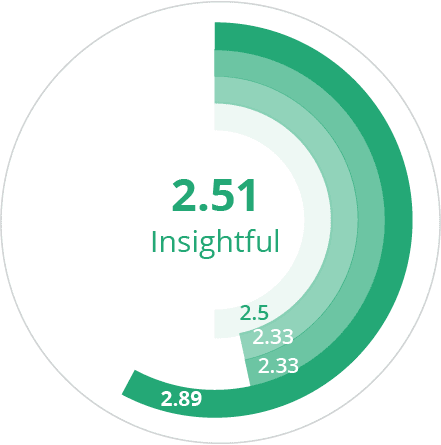 | 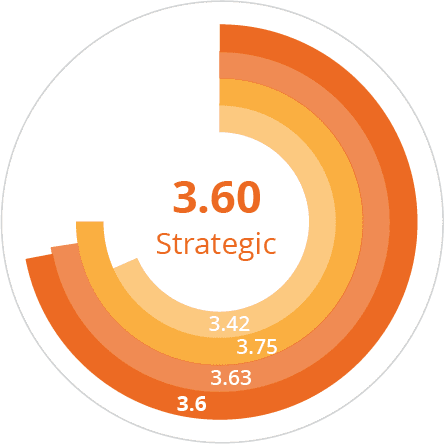 |
Organization 2.67 | Technology 2.89 | People 3.6 |
Strategy 2.83 | Metrics 2.33 | Culture 3.63 |
Leadership 2.69 | Data 2.33 | Capabilities 3.75 |
Investment 2.5 | Data Governance 2.5 | Adoption 3.42 |
Along with the final maturity score is a 10+ page report highlighting your current capabilities.
Common People Analytics Challenges
From our early assessments, we have identified the most common challenges that organizations face within each driver.
Organization | Technology | People |
|---|---|---|
| Strategy: There is an overall lack of decision-making within roles or a structure to support decision-making. | Data: Challenges around organizing domain-specific data and allowing for engineer access for different users. | Culture: There is a growing divide in corporate digital cultures and it's creating a digital skills gap. |
| Leadership: There is a level of awareness, but not enough practical understanding and use of analytics at senior leadership levels. | Metrics: Few organizations have standardized metrics, leaving data to be interpreted haphazardly. | Capabilities: Organizations are investing in hiring capabilities that may be beyond what's realistically achievable as defined by the organization. |
| Investment: Organizations don't invest in non-digital activities or linking the digital change to existing systems. | Governance: Organizations are overestimating their data governance capabilities and are open to unrealized risks. | Adoption: Perceptions can be affected by low levels of investment into change management or co-developing applications with end-users. |
Some more observations on the challenges that organizations face when improving their people analytics:
Organization
In the organization driver, we noticed these factors slowing down the adoption of analytics:
- Not understanding the types of decisions being made
- Needing different data for different roles
- The analytical team’s ability to present the right data to the right people at the right time
- Leadership’s willingness and ability to use analytics
- Not investing in non-digital activities to support analytics adoption
This is commonly the least mature driver, with an average score of 2.6.
People
One people-related challenge we noticed was the digital gap. It seems to be getting wider.
Nearly everyone works with technology, but not everyone works with personal computers. People that don’t use computers can lack critical digital and other skills needed to keep up with changes in HR technology.
Organizations also tend to burn through analytical talent. They aren’t realistic about necessary skills and over-hire. Talent doesn’t get to use their hard-earned skills. They end up disengaged and looking for new projects and opportunities.
People still tend to be one of the most mature business areas, with an average score of 3.4.
Technology
Most organizations, no matter how mature they are, struggle with:
- Data quality
- Integration
- Access
- Developing metrics
- Creating a standardized way to develop metrics
This driver has an average score of 2.8, but if we remove the governance scores, it falls to less than 2.4.
More About Rizing’s People Analytics Assessment
If you’re interested in learning more about where your organization falls in these different areas, consider taking our assessment. It’s easy to access online and you can complete the survey on your phone.
More about the survey:
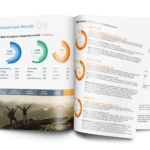
- What: An online assessment using Qualtrics.
- How long: Takes ~30 minutes to complete.
- Turn around: Report returned in five business days.
- Why: Personalized insights and recommendations.
- Who: A head of/VP/Director of People Analytics should take the assessment.
- Report: Written for all senior-level HR Leaders.
- Follow-up: Clients will have a one-hour follow-up call with a Rizing expert to review the findings and help interpret the report.
Common Use Cases
- Measuring current capabilities as an assessment and benchmark.
- Complete assessment annually as part of an ongoing assessment/used as part of KPI.
- Before and after a major deployment or new initiative as part of measuring the impact of the project/measure of success.
Ready?
Ready to get started on your own People Analytics Maturity Assessment? Head over to the assessment request form to get started.
The post People Analytics: How Rizing Helps Organizations Measure Their Analytical Capabilities appeared first on Rizing.
]]>The post So, you think you know People Analytics . . . Let’s ask the Professor appeared first on Rizing.
]]>When it comes to designing and developing solutions to help our SAP SuccessFactors customers excel, we don’t create based on what we think you need. Intention, research, and dialog are part of the design. That’s how our Lyra on SAP® product began and continues to evolve today. Still, we know we don’t have all the answers.
Asking the right questions
That’s why we invite people like Professor Andy Charlwood to join us in conversations and research intended to enable our clients to get to the core meaning of People Analytics and what Human Resources professionals really need to know – not just for today but for the future. As a Professor of Human Resources Management at the University of Leeds, Professor Andy is a scholar of HR Analytics, Artificial Intelligence, and algorithmic management in HR. He focuses on job quality and subjective well-being at work and in the healthcare workforce.
Unfortunately, as Professor Charlwood shares with us, HR is often relatively peripheral (compared to Finance and Operations) when it comes to how the data and technology should be used. At times there has been a degree of mistrust between the dominant organizations of Finance and Operations and HR and definitely incomprehension about how People Analytics can add value to managing this resource we call people.
Defining your own organization’s needs
To get past that, we in HR need clarity about our analytics maturity compared to available solutions and the future we want to achieve. It’s more than just nice dashboards and KPIs. The secret sauce isn’t buying another niche product that solves a challenge we have today. Rather, it lies in clearly understanding expectations about how People Analytics can contribute to the organization’s future. In that respect, each organization’s story is unique.
We are listening. Where you are on your own journey is the first step in helping you understand how to excel at People Analytics, strategy, and influence.
Rizing’s People Analytics Maturity Assessment is a starting point to help. Your interaction with us and with each other is vital to having an assessment make sense.
Join the conversation. Be part of your solution.
1) Understand your People Analytics journey. Join our webinars this week:
November 15th at 1:00 pm GMT with
Professor Andy Charlwood,
our Future of Work Strategist, Megan Butler and our
President of HCM at Rizing, Joanna Murphy.November 17th at 3:00 pm AEDT/12 pm SGT with
our Future of Work Strategist Megan Butler and our
Vice President of Employee Experience, Mark O’Donnell.
2) Find out if you are eligible for our complimentary People Analytics Maturity Assessment
3) Take the assessment and bring the results and talk to us about how we can help you get out of the back office and in front of Finance and Operations with analytics that matter.
The post So, you think you know People Analytics . . . Let’s ask the Professor appeared first on Rizing.
]]>The post Customer’s Big Bang SAP Launch Was Three Years in the Making appeared first on Rizing.
]]>Big Bang
Depending on your interests, the Big Bang Theory usually refers to:
- An explanation for how our universe came into existence
- A sitcom that ran on CBS for 12 seasons
For Rizing Vice President, Business Development APAC Martin Greaves, “Big Bang” has a different (non-theoretical) meaning:
“It’s the typical implementation where you’re basically bringing all key processes for the organisation online at the same time,” he says.
Martin was describing the recent go-live of an SAP® S/4Hana implementation for a large Australian energy provider.
Three years in the making, elements of the big-bang go-live included:
- Enterprise Asset Management
- GIS integration
- Mobility system integration
- Project systems
- Plant maintenance
- Vegetation management
- Safety incident management
- Environmental management
- Operational risk
- Compliance
Dozens of Rizing staff
According to Martin, leading up to the go-live involved a large team of Rizing employees.
“Currently, we’ve got 25 functional people involved and another ten as part of an offshore digital design centre team,” he says.
COVID Impact
COVID has impacted how the work got done.
“The work had primarily been done face to face until about four months ago,” Martin says. “Since then we’ve been completely remote through user acceptance testing, cutover, and go-live.”
Power through partnership
The project was large enough in scale that Rizing worked closely with partners on the project.
“We partnered with Syniti,” says Martin. “They were in charge of the data extraction, transformation and migration.”
IBM was also involved, handling the finance and supply chain portions of the project.
Business benefits
Part of Rizing’s involvement in the project included mapping out expected business benefits the customer could expect to enjoy post go-live.
Cost savings, increased revenues, or improved efficiencies are expected in:
- Capital planning
- Asset strategy and maintenance
- Work management
- Customer Service
- Risk Management
- RIN Compliance
- Data governance and integration
Current project status
Rizing’s work doesn’t end when the go-live switch is flipped.
“We’re currently in hyper-care, which is a heightened support mode,” says Martin. “That will last three months, then there’s a warranty period.”
The first of 1000 steps?
Project launches are often celebrated as the end of a long process involving extreme amounts of planning and elbows-deep work.
And they are all of that.
But that’s not all they are.
“When you go live, it’s not the end,” says Martin. “It’s really the beginning.”
Elsewhere on Rizing.com:
- Press release: Rizing/Syniti Announce Partnership
- Blog post: Five Things I Wish I Knew Before I Started a Global Software Implementation Project
- White paper: Everything to Know About EAM Data Conversion
The post Customer’s Big Bang SAP Launch Was Three Years in the Making appeared first on Rizing.
]]>The post Why Healthcare Workers Are Twice As Likely to Quit and What To Do About It appeared first on Rizing.
]]>Chief Human Resources Officers are faced with new internal challenges. To overcome them, the end-to-end companies need to prioritize the employee experience. When employees feel empowered and engaged at work, the organisation will benefit from improved job performance and productivity, staff retention and better quality of care. Higher healthcare worker satisfaction resulted in an 87% decrease in infection rate, according to the National Database of Nursing Quality Indicators (NDNQI).
In today’s digital-first world, the best way for healthcare providers to achieve a positive employee experience is using SuccessFactors® from SAP® for Human Capital Management.
Rethink employee experience to respond to today’s challenges
In healthcare, the employee experience depends on a series of factors including:
- Job expectations
- Workplace culture
- External circumstances (like COVID-19)
- The quality of the organisation’s response to challenges
Because of the unpredictability of external events, the healthcare sector faces unique challenges in creating a positive employee experience. For example, COVID-19 has led to an increased need for nurses and doctors, and in turn, increased competition within the sector. Hiring, scheduling and rostering processes are disrupted as HR teams scramble to recruit skilled professionals that have the right qualifications and training for the required tasks.
Fluctuating demand for services has also given rise to a more mobile workforce. Technology can be a valuable investment to support Chief Human Resources Officers and HR teams identify and hire talent to allow healthcare organisations to keep up with the pace of change.
By streamlining the recruitment process, onboarding and knowledge transfer becomes more efficient. It helps remove organisational-wide challenges caused by under-qualified new hires and under-staffed teams.
“Healthcare employees who experience a sense of belonging, purpose, achievement, happiness and vigour perform at higher levels and are more likely to contribute ‘above and beyond’ expectations. They are also less likely to quit.”
– IBM, Smarter Workforce Institute
Risky business: The consequence of unhappy healthcare workers
Patient care is a critical priority. So is the employee experience. When Chief Human Resources Officers fail to prioritise the employee experience, consequences include:
- Declining productivity
- High staff turnover
- Low customer satisfaction
These consequences inevitability impact a healthcare organisation’s bottom line and extend far beyond HR.
The ‘ripple effect’ of poor employee experience has an organisational-wide impact. When healthcare workers experience burnout, consequences not only include lower patient satisfaction but also the increased likelihood of medical errors, which may end up in malpractice suits. Inadequate or overworked management may result in unintentional mistakes and injuries. This puts the healthcare organisation at risk of severe financial risk, legal risk, and a damaged reputation.
While prioritising employee experience may take the backseat to direct profit-generating HR activities, the subsequent costs will creep up sooner or later.
An employee experience designed for success: satisfaction, engagement, and beyond
Modern human capital management software can better inform Chief Human Resources Officers who must balance demands from individual employers and the wider organisation. A well-thought-out SAP SuccessFactors Solution includes several features designed to support human resources provide a positive end-to-end employee experience. These features span across all stages of the HR process:
- Learning and development
- Payroll solutions
- Shift scheduling
A positive end-to-end employee experience is crucial to overcome the challenges facing healthcare workers, managers and organisations today.
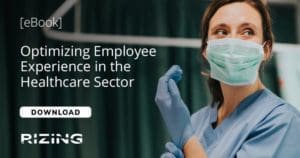 Optimize your healthcare organization
Optimize your healthcare organization
Rizing has deep human capital experience and provides award-winning HR technologies to boost both the employee experience and your bottom line. Rizing supports organisations as they learn to better understand and respond to the demands and needs of their employees.
Want to learn more about how to optimize employee experiences in the Heathcare industry? Download our free eBook.
The post Why Healthcare Workers Are Twice As Likely to Quit and What To Do About It appeared first on Rizing.
]]>The post Field Report: 2021 MasteringSAP EAM Conference appeared first on Rizing.
]]>This was my first time attending the MasteringSAP EAM conference. I attended both the virtual conference and the live conference in Canberra. It was a great event to meet people located all around Australia from a variety of different industries and organisations.
In the virtual conference there were many informative sessions ranging from presentations with existing SAP® clients to system implementors explaining the latest and greatest in SAP solutions.
EAM Master Class
One of the sessions I found insightful was the Managing your Assets from Cradle to Grave masterclass presented by Rizing Solution Architects John Dwyer and Marty Ravell.
This session went through the asset lifecycle from end-to-end (E2E) and how to manage this through SAP via:
- Business Planning and Consolidation (BPC)
- Portfolio and Project Management (PPM)
- Project systems (PS)
- Work Orders
In this session the overall SAP solution was clearly outlined as well as some of the gaps and a few options that could be used to fill the gaps:
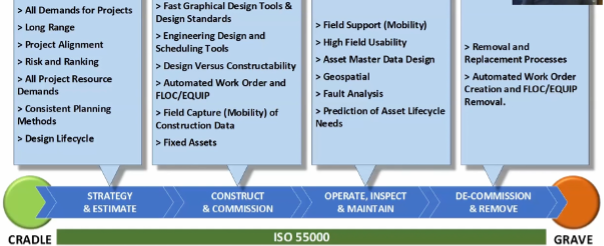
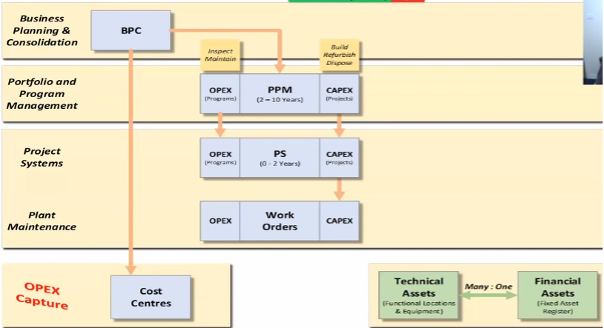
Q&A
During the session anyone viewing could add their questions to the discussion forum and the presenters could then respond to the questions in a Q & A format at the end of the presentation.
The Virtual Lounge
My favourite experience during the conference was the Virtual Lounge, a virtual space where you could float around to different groups and meet new people. As you move your persona around the virtual space, your video and audio would automatically connect with others, almost as if you were walking around in a physical face-to-face conference.
This was a great way to meet people in different industries who were dealing with different EAM-related issues. It allowed us to bounce ideas off each other.
Guest Speaker
The guest speaker at the conference was a safari guide from South Africa. He explained how similar a pride of lions is to running a successful business/team. The performance was very engaging and insightful.
Following the presentation, we all broke up into groups, allowing us all to meet, have a drink and discuss with each other the latest in SAP EAM. This gave the SAP clients/Future SAP clients the ability to ask the experts any questions that come to mind.
The EAM Journey
Whether you are a new, familiar, or long-term SAP EAM user, MasteringSAP’s EAM Conference is a great event to help you progress on your EAM journey. It is a great event for networking and there is an abundance of the latest and greatest information available.
The post Field Report: 2021 MasteringSAP EAM Conference appeared first on Rizing.
]]>The post Our Top 7 Project Management Lessons Learnt – and Advice for Global Cloud HCM Implementations appeared first on Rizing.
]]>“No one can whistle a symphony. It takes a whole orchestra.” – H.E. Luccock
The global cloud HCM implementation’s fast pace requires that alignment and expectations are set from the beginning within the sales phase. The customer needs to understand what they bought, and both the customer and the implementation partner (project management team) need to agree on a realistic implementation from a scope, timeline, resources, etc. perspective.
1. Stakeholder and Work-Council Engagement
Stakeholder and work-council engagement is key to project success. They need to be kept up to date from the beginning of the project, understanding what is being implemented, process alignment, data security and audit, etc. This will allow them to provide the level of support required, sponsorship, sign-off, etc.
Not being aligned can cause important delays and an impact on budget, timeline, etc. and affect the quality of the project management.
2. Data Quality
One of the most important project management activities is to have the data quality to the level expected. This can be achieved only if the customer has a good understanding of the current data quality of their current legacy systems, so action plans (data cleansing, audit, etc.) can be put in place aligned with the project implementation.
The new HCM system will work based on the data quality. If the data quality is low, this will cause the customer’s organization to lose confidence having a poor end user adoption, employee experience, etc.
3. Process Alignment
Global Cloud HCM implementations mean the need to move from de-centralized processes into global and consistent processes. To achieve this, it’s critical for the customer to understand what processes are in place within the different countries, business units, etc. and assess how this can be consolidated into global processes and what could be the exceptions that need to be considered. It’s strongly recommended for this activity to be run in parallel to the product and implementation partner selection process. This will allow to match customer needs with product capabilities and simplify where possible.
If the above due diligence is not made, this can cause important delays and an impact on budget, timeline, etc.
4. Project Management Scope, Timeline and Governance
Global Cloud HCM implementations normally have extensive scope and adjusted timeline to be implemented. Therefore, it’s critical for both the customer and the implementation partner to understand and agree on the scope and timeline from the beginning.
The recommendation is to not deviate from scope during the implementation where possible. A strong customer governance needs to be put in place, so enhancements, nice to have functionality, etc. can be addressed once the project is finalized.
If the above can’t be followed, this can cause important delays and an impact on budget, timeline, etc.
5. Resources and Level of Knowledge
Resource availability with the right level of knowledge can make the difference between a successful and a failed implementation. Global cloud HCM implementations expand beyond the need to identify a project team. There are normally high number of countries in scope that need to be engaged within the project within several activities (global process alignment, testing, sign-off, etc.) and therefore the adequate resource structure needs to be put in place.
If the above can’t be followed, this can cause important delays and an impact on budget, timeline, etc.
6. Communication, Change Management and Training
A big mistake is to focus on the implementation per se, aligning processes, testing, etc. and forget key activities like communication, change management and training. These need to be run in parallel to the implementation to ensure that employees, managers, etc. are ready to use the solution by when go-live is achieved.
If the above can’t be followed, this can cause issues towards poor end user adoption, employee experience, etc.
7. Project Management Support Model
Often the support model preparation activities are not started until late in the project, which is a big mistake. The recommendation is to identify from the project team members who will be the administrators at the beginning of the implementation. These will allow them to have the right knowledge and expertise, so they can support the solution once is live.
Conclusion
Understanding the complexity of these global cloud HCM implementations will allow to plan carefully and ahead of time. This will reduce the risks and unknowns as much as possible before the implementation starts, leading into the path of success.
Looking to start an SAP SuccessFactors project, but not sure how to tackle us? Reach out to our team of experts with your questions.
The post Our Top 7 Project Management Lessons Learnt – and Advice for Global Cloud HCM Implementations appeared first on Rizing.
]]>The post Three Reasons Companies Overlook Enterprise Asset Management appeared first on Rizing.
]]>- Dialogue in an action movie will always be heard above the din of car chases and explosions.
- Every pregnant sitcom character must attend a Lamaze natural childbirth class accompanied by the least suitable partner possible.
One classic trope is Poor Communication Kills. One character withholds information from another, causing them to make poor decisions or mistakes. Hijinks ensue, right up until when the hero realizes where the communication broke down and saves the day.
According to David Harrison, Rizing’s Director of Business Development in Asia, poor communication isn’t just a factor in TV plots. It’s one of his three reasons an Enterprise Asset Management (EAM) Strategy is often overlooked:
1. Communication challenges
“Maintenance people can find it a challenge to take off the overalls, put on the suit and head up to the 7th floor to tell the company C-suite that a piece of equipment isn’t getting maintained correctly,” Harrison says. “And by not maintaining it right, the company is at a greater health and safety-related risk. Or worse.”
It’s not just the wardrobe change that makes that task difficult. The maintenance staff may not have the language of the C-suite to tell their story.
2. Focus on maintenance
“If you’re a maintenance organization and not asset management focused, you can’t communicate the entire picture.” says Harrison. “If you take your car to a workshop for repairs, they just fix it. They don’t care what you’re going to do with that vehicle tomorrow, next year, or in five years.”
“That’s just maintenance,” he says. “But asset management is about understanding the life cycle of that asset. Is the asset doing its job? How is it being used? Can I get better value out of it? Can I keep it longer? Should I upgrade it? When should I sell it?”
For the C-suite you need a business case based on the right data that is accurate. A maintenance-focused company isn’t going to have the right data to support the right story to share with the C-Suite.
And not being able to cost-justify themselves, the inevitable happens.
3. Trimmed budgets
“Maintenance shops are viewed as a cost center,” says Harrison. “Without a bigger picture story to tell, there’s a tendency to go ‘Well, you can’t justify your budget as well as other departments, so we have trimmed your budget by 10%.'”
But don’t despair. There is hope.
EAM changes the narrative
“With a good EAM system, you have the data to justify your expenditure,” says Harrison. “You can say ‘75% of my costs are overhauls and preventative maintenance. Which of those projects do you want me to stop doing to meet that smaller budget?'”
The data can then be used to show the effects of a particular decision.
“Asset Management processes managed through a robust system will show people what they get for their money,” says Harrison. “If by doing less preventative maintenance we now know we’re doubling the odds of an outage that costs, say, $1,000,000 a day, that’s an easy sell for the right budget.”
Happy endings
“At Rizing EAM we help asset-intensive companies optimize their asset management and SAP EAM solutions so their operations can run efficiently and users can work smarter,” says Harrison. “We are not your typical professional services and solutions firm. We’re EAM business experts who are also IT solution providers.”
Trim the trope
Learn more about how your business can avoid becoming yesterday’s trope: Rise with SAP and Rizing.
The post Three Reasons Companies Overlook Enterprise Asset Management appeared first on Rizing.
]]>The post H2 2021 SuccessFactors Release Analysis: Payroll appeared first on Rizing.
]]>More H2 2021 analysis:
Employee Central | Recruiting | Onboarding | Learning | Analytics | Performance & Goals | Compensation and Variable Pay | Payroll
Update video
If you prefer video, Rizing’s AMS Senior Consultant Eray Kocaman and Professional Services Principal Consultant Eric Miner discuss the new features in the SuccessFactors Payroll module on the Rizing HCM YouTube Channel:
This article will be covering the Payroll Module in the H2 SAP SuccessFactors 2021 release. The SAP What’s New Viewer has a full list of changes along with the release notes.
The updates in H2/2021 will be available in HR Support Pack 99. Visit SAP’s Support Pack Release Schedule for more information.
Here are the categories covered below:
- Employee Master Data Replication
- Time Data Replication
- Payroll Control Center
- Other
Employee master data replication
Country/region-specific mapping support for no-shows
You can now configure a country/region-specific code value mapping for a No-Show event to replicate it to a country/region-specific inactive hiring action in the Employee Central Payroll system.
Rule function for get payroll area control record
With this rule function, you can create a business rule to validate changes when employee data is included in the payroll control record in Employee Central Payroll. For example, in the Employee Central Payroll system, if the payroll control record status is ‘RELEASED_FOR_PAYROLL’, you aren’t allowed to change data from Employee Central blocks Job Information, Payment Information, Compensation Information.
Time data replication
Complete payroll tasks for absences
In Payroll Unified Configuration, payroll administrators can configure tasks of time type Absence for Payroll Tasks.
With this feature, payroll administrators receive tasks based on time type as Absence in Complete Payroll Tasks. Payroll administrators can also filter employees using time type of classification Absence.
Proxies deletion support for time data
The Trigger Data Replication Proxy Deletion Job allows you to delete proxies that are no longer needed in Employee Central Payroll.
This feature offers an easier and more efficient way to delete the obsolete proxies as part of system maintenance. Where previously you achieved this result using the Import Data function, that was rather cumbersome, now you have a designated feature.
Enhanced Logic Support Dealing with Very Old Data Replication Proxies in Non-Productive Systems
We now have automatic logic to avoid unnecessary replication attempts when the Employee Central Payroll systems are non-productive systems. After 150 failed attempts at replication, the next attempt is set to 1000 years into the future, that is, no further attempt is done.
Payroll Control Center
Audit Trail Archiving in Payroll Control Center
You can now archive the audit trail of completed process recurrences of Payroll Control Center using the archiving object PCC_AUDIT.
You can archive audit trail for completed process recurrences if the residence period is fulfilled and read the archive files during the blocking period.
Enhanced Manage Configuration of Payroll Control Center
We have now enhanced version of the Manage Configuration application in Payroll Control Center for configuring validation rules, KPIs, and analytics. Simplified configuration of analytics, Preview of validation rules.
Other
More Quick Actions on the Latest Home Page
The latest Home Page, available to use since the H2 2020 release, can be used via the web and in mobile apps for a more consistent experience across all devices. The nature of content on the latest home page is dynamic. Content displaying is dependent on Provisioning/Upgrade Center features and RBP permissions.
A Quick Actions section is available, where you can complete your most frequent or important actions. Quick actions allow users to perform a quick task without navigating away from the Home Page. SAP has added more quick actions to the latest home page with this release, such as My Team, Completed Payroll Tasks.
Open Payroll Information Links in New Tab
Certain custom URL links could not be opened within the Payroll Information People Profile page due to technical constraints. This feature allows payroll administrators to configure URL links to open in a new tab.
Need Help?
If you need help with any of these SuccessFactors features please contact us.
The post H2 2021 SuccessFactors Release Analysis: Payroll appeared first on Rizing.
]]>The post H2 2021 SuccessFactors Release Analysis: Compensation & Variable Pay appeared first on Rizing.
]]>More H2 2021 Analysis:
Employee Central | Recruiting | Onboarding | Learning | Analytics | Performance & Goals | Compensation and Variable Pay | Payroll
Update Video
If you prefer video, join Rizing’s AMS Consultant Tracy Kramer as she breaks down the new features in the Compensation and Variable Pay in this video from the Rizing HCM YouTube channel:
Publishing Enhancements and Updates
Following the SuccessFactors trend to provide a more dynamic and stress-free way to publish from compensation plans to Employee Central, this release provides several important and easy to use tools.
Integration with SAP Employee Central (EC) is required.
Configuration
- We can now publish to Compensation Information fields that aren’t specific to recurring or non-recurring pay components.
- We can also now publish back to a custom MDF object created to capture compensation information.
Both upgrades remove manual intervention for the admins by allowing them to publish directly instead of exporting/importing after the cycle is complete.
While the Comp Info option is a universal upgrade, the MDF option does require provisioning to enable.
Cycle maintenance
- There is the new Employee Central Publish Report. This report is part of the Complete Compensation Cycle > Publish Data menu and provides a post-publish report that you can export as a spreadsheet to view.
- We are now able to select up to five fields to include in the publish filter instead of just one, allowing flexibility in aggregating groups to publish.
Both features are self-service, but the new publish report will require a Role-Based Permissions (RBP) update to your compensation administrator role to be able to view and run.
Advanced Executive Review Upgrades
Advanced Executive Review Filters were released in H1 2021. The H2 release includes significant enhancements to make this tool more efficient and user-friendly.
- We are now able to disable population views that aren’t relevant to your instance. For example, if you don’t use Matrix Managers, you can disable the Matrix Reports view from the Advanced Exec Review Filters to make the options more intuitive for your planners.
- We can use a newly added filter option Outside Guidelines or Salary Range option in the Filters Options. This can be added to any filter and toggled between Yes/No to see populations within or outside of guidelines or salary range.
If you haven’t enabled this feature, it’s worth reviewing. It’s enabled in the Actions for All Plans > Company Settings > Enable Advanced Executive Review Filters.
The feature will be on for all users and all plans, but with the ability to save filters, toggle between filters, filter using field on the compensation plans, and other features specific to this advanced tool, it’s worth learning.
Bulk Print in Executive Review Upgrades
This is a much-anticipated tool used to bulk print compensation statements from Executive Review. It’s had a shift in configuration, moving from the module level to the planning template level.
- First, the checkbox to enable this feature is now on the Page Setup > Settings > Settings page, at the bottom.
- This field is dynamic, allowing it to be updated during the planning cycle. This shift also provides more detailed log files indicating whose statements were printed, excluded, or unavailable.
- Second, the Download Statements popup now presents a navigation hyperlink to Check Print Job Status, taking the planner straight to the reporting queue where the statements will print.
This navigation saves planner up to five clicks and offers even more instruction and guidance on how to access print jobs.
Both upgrades are universal and available with no additional permissioning or intervention.
Spot Awards Now includes Anniversary Awards
You can now create awards using the Points-Based program to celebrate employee anniversaries or other service awards. The awards program can be set up to respect different milestones as well as different recognition by country, region or regional subgroups.
The post H2 2021 SuccessFactors Release Analysis: Compensation & Variable Pay appeared first on Rizing.
]]>The post H2 2021 SuccessFactors Release Analysis: Learning appeared first on Rizing.
]]>More H2 2021 Analysis:
Employee Central | Recruiting | Onboarding | Learning | Analytics | Performance & Goals | Compensation and Variable Pay | Payroll
Update Video
If you prefer video, Rizing’s AMS Senior Consultant Carey Ross and AMS Senior Consultant Chris Fellabaum discuss the new features in the SuccessFactors Learning module:
The H2 2021 Learning release breaks ground in a few notable areas, particularly integration points with other modules or systems. Course Home Blended continues to evolve. PQE is going away. And customers with native Learning users, take note – action is needed soon.
Microsoft Teams VLS integration
This fulfills a long-standing request from customers. The MS Teams VLS integration offers the same capabilities as existing VLS integrations (i.e. WebEx, Adobe Connect, Zoom) – namely the ability to dynamically schedule a virtual class, allow learners and instructors to join the session directly from Learning, and set an automated completion threshold – e.g. if a learner attends 90% of the session, they automatically get credit for the Class in Learning.
Configuring the integration
The Teams integration is a bit unique, however, in that SuccessFactors Partners are not able to configure it from A to Z as with other supported VLS vendors. Customers will also need to work with a Microsoft Partner to register the MS Teams app and complete other required tasks within the Microsoft Azure Portal.
SAP SuccessFactors Opportunity Marketplace
What is SAP SuccessFactors Opportunity Marketplace?
It’s a new module from SuccessFactors, which (in SAP’s words), is “a central hub for all learning and development opportunities available to the user… Learning is a core source of development for employees. Opportunity Marketplace showcases a personalized view of this alongside all other available opportunities, providing clarity of options that are tied to the user’s own interests and passions.”
Opportunity Marketplace must be licensed separately from Learning.
Learning Recommendations and Assignments
In this release, users can view Learning Recommendations and Assignments available to them, within the Opportunity Marketplace framework.
It’ll be exciting to see how synergy grows between Learning and Opportunity Marketplace in future releases.
Migration of Learning Competencies to Center of Capabilities
In this release, for customers who migrate competencies from Job Description Manager to Center of Capabilities, the migration will also be triggered in Learning. Center of Capabilities requires Job Profile Builder as a prerequisite.
What is Center of Capabilities?
In SAPs words, it’s “a framework that helps you capture capabilities, such as competencies, skills, work styles, work values, and other organization-defined attributes that enable people achieve desired outcomes.”
Other features possible
According to SAP, there may be additional Learning features relative to Center of Capabilities in future releases, including use of Skills in Learning. This would represent a significant new paradigm for assignment of training.
New UI Integration Cards in SAP SuccessFactors Work Zone
This release also adds support for several “UI Integration Cards” (think Learning Portlets) to SAP SuccessFactors Work Zone.
SAP SuccessFactors Work Zone is the successor to SAP JAM.
New UI Integration Cards include:
- My Learning Calendar
- Required Learning
- Curriculum Status
- Learning Plan
Course Home – Blended
SuccessFactors continues to add features to Course Home – Blended for Learning. Building on customer feedback, Course Home – Blended can be viewed as a “version 2.0” of the original Course Home functionality, both offering a more elegant user interface when learners access items.
This release introduces support for instructor-led Item Classification, following its rollout with support for Blended Items in H1. According to SAP, support for remaining Item Classifications will be added in future releases. We assume that Course Home – Blended will supersede the original “Course Home 1.0” when that effort has been completed.
Content player
Other Course Home – Blended improvements included in this release are an enhanced Content Player – which automatically hides the content structure when Blended Items only have one Content Object.
Mobile App
Support for delivery of Assessments on the SuccessFactors Mobile App has also been added – but again, Course Home – Blended must be turned on to leverage these capabilities.
No sunsetting timeline
At this point, both Course Home and Course Home – Blended are opt-in features, and there has been no timeline provided by SAP for sunsetting the legacy course view.
PQE (Plateau Question Editor) Retirement
We knew it was coming, but with this release PQE is no longer available. It’s deprecated in favor of the newer (and nicer) Assessment tool in Learning.
Customers who haven’t migrated their legacy PQE exams to Assessments have a very short window in which to do so prior to the November 19th Production release.
Item Connector updated
In this release, the Item Connector has been updated to allow bulk removal of legacy PQE exams from Items, which could be helpful for customers with numerous affected Items. This builds on a feature in the last release which allowed association of Assessments with Items.
Identity Authentication Integration for Learning-Only Users
Customers with native Learning users (i.e. ones who exist in Learning only, are not in Platform, and who log in directly to Learning through a native URL or Site) need to take action soon.
SAP is replacing native user sign-in and sign-in for integrated external learners with Identity Authentication based login.
Have native users?
Customers with native users must implement IAS within Platform as a prerequisite and will then be able to migrate those native users to IAS authentication.
Per SAP, “This feature is going to be rolled out after availability of the Identity Provisioning Connector for SAP SuccessFactors Learning, currently targeted for early 2022.”
Deadline uncertain
There is currently some ambiguity regarding the deadline to complete this migration; some SAP sources indicate that it will be H1 2022, others reference H2 2022. We recommend subscribing to the official Customer Community Blog on this topic for the latest communication from SAP:
Learning Native Login Deprecation Begins Within First Half 2021 Release – Innovation Alert
Need Help?
If you need help with any of these SuccessFactors features please contact us.
The post H2 2021 SuccessFactors Release Analysis: Learning appeared first on Rizing.
]]>